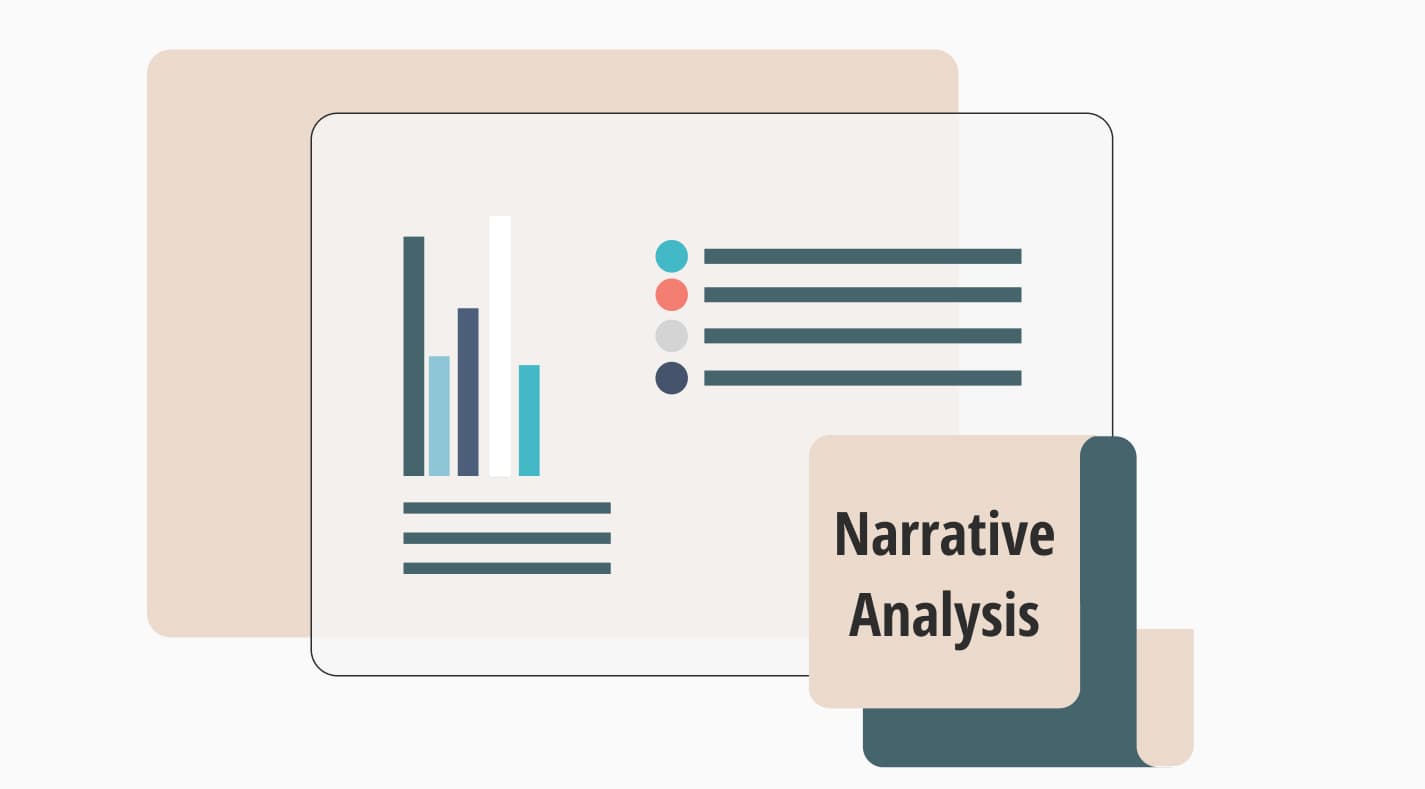
In today's fast-paced business environment, strategic planning tools are essential for growth and long-term stability. These models help organizations identify and navigate opportunities for market and product expansion, ensuring long-term success. Businesses using them can stay ahead of the competition, adapt to market changes, and achieve their growth objectives efficiently.
In this comprehensive guide, we'll explore the Ansoff Matrix, its components, template, and practical application. We'll also discuss real-life examples, pros and cons, suitable usage scenarios, and frequently asked questions. You will thoroughly understand how to apply the Ansoff Matrix to enhance your strategic planning.
What is the Ansoff Matrix?

The Ansoff Matrix of Igor Ansoff (1957) is a strategic tool for businesses to plan and analyze growth strategies.
It focuses on two main dimensions: markets and products. This helps companies decide whether to market new or existing products in new or existing markets. This matrix presents four strategic options: Market Penetration, Market Development, Product Development, and Diversification.
This model serves as a framework for companies to evaluate their current market position and identify potential growth opportunities. By analyzing these four strategies, businesses can make informed decisions about where to focus their efforts and resources. The Ansoff Matrix not only aids in strategic planning. It also helps in assessing the risks and rewards associated with each growth option.
The Ansoff Matrix: Explained
The Ansoff Matrix, a cornerstone of strategic planning, offers a structured approach to growth strategies. By examining market and product dimensions, it provides a framework for businesses to explore expansion avenues. Let's delve deeper into this model to understand its application and significance in business development.
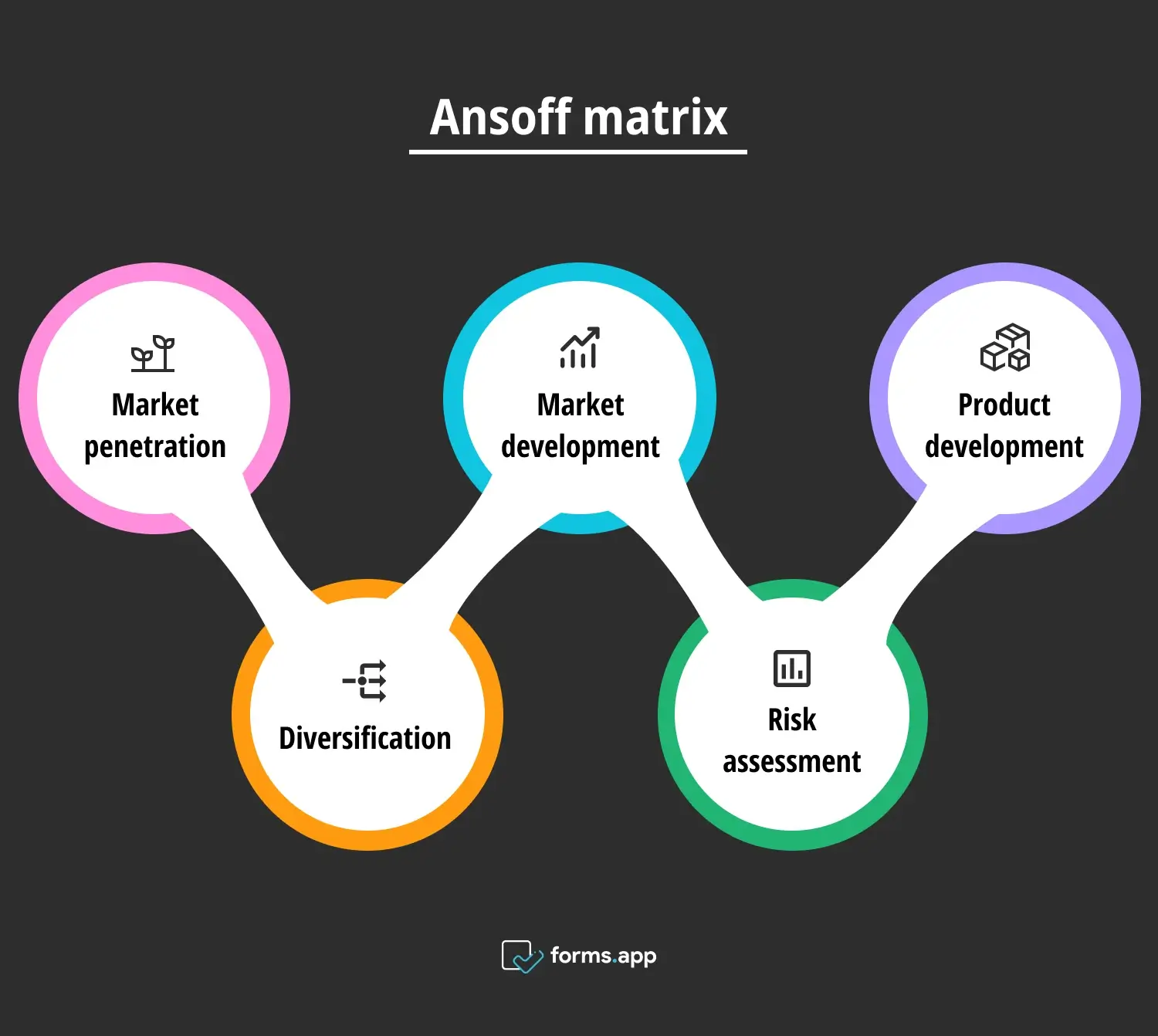
The Ansoff matrix
1. Market penetration
Market Penetration involves increasing sales of existing products in existing markets. This strategy focuses on gaining more market share through aggressive marketing, competitive pricing, and enhanced customer engagement. It is often the least risky growth strategy. Because it builds on a company’s existing capabilities and market knowledge.
Companies can also employ marketing strategies such as the 3Cs of marketing. They can boost market presence by using promotional campaigns, loyalty programs, and improving product availability. Businesses can strengthen their position in the current market and achieve growth without the need for significant changes or new investments.
2. Market development
A Market Development strategy aims to introduce existing products into new markets. This could involve geographic expansion, targeting new customer segments, or finding new uses for a product. This strategy can open up significant growth opportunities. However, due to the unpredicted factors of new markets, it also involves moderate risk.
Businesses need to understand marketing very well. They can use analyses like 7Ps of marketing. They must understand the new market's dynamics, customer preferences, and regulatory environment. Effective market development requires a well-planned entry strategy. This includes partnerships with local businesses and adapting marketing messages to local cultures.
3. Product development
Product Development strategy entails creating new products to serve existing markets. This strategy leverages the company’s understanding of its customer base to meet evolving needs. It requires substantial investment in research and development and carries risks related to product success and market acceptance.
Companies need to innovate to stay relevant and competitive. Product development can include adding new features to existing products, developing entirely new products, or enhancing product quality. Effective product development requires a deep understanding of customer needs, robust R&D capabilities, and efficient product launch processes.
4. Diversification
Diversification involves entering new markets with new products. This strategy is the most risky as it combines the uncertainties of both new markets and new products. However, successful diversification can lead to significant growth and reduce dependency on current markets or products.
Diversification has two types: related diversification (leveraging existing capabilities) or unrelated diversification (venturing into entirely new industries). It requires careful analysis and planning to identify viable opportunities and assess potential synergies and risks. Companies must invest in new competencies and adapt to unfamiliar environments to succeed in diversification.
5. Risk assessment
Each strategy in the Ansoff Matrix involves different levels of risk. Market Penetration is the safest, followed by Market Development and Product Development. Diversification is the riskiest, requiring careful analysis and planning to mitigate potential downsides. Companies must evaluate their risk tolerance and capacity to manage uncertainties before selecting a strategy.
A balanced approach, combining lower-risk and higher-risk strategies, can help achieve sustainable growth. Risk assessment involves analyzing market conditions, the competitive landscape, and internal capabilities. It enables informed decisions about the most suitable growth path and staying ahead of competitors.
The Ansoff Matrix template
The 2x2 Ansoff Product Market Grid with the dimensions of markets (existing and new) and products (existing and new). This simple yet powerful tool helps businesses visualize their strategic options and make informed decisions about growth initiatives. Companies can use this template to map their positions and explore potential growth strategies.
By plotting different strategies on the matrix, businesses can compare their potential impact and risk levels. The template is a visual aid to facilitate strategic discussions and ensures considering all growth opportunities. The Ansoff Matrix template provides a structured approach to strategic planning. It allows businesses to evaluate their current market presence and product offerings.
It helps identify gaps and opportunities for expansion, ensuring a comprehensive analysis of growth options. By using this template, companies can align their strategic initiatives with their overall business goals and market conditions. The visual representation of strategies on the matrix also aids in communicating plans to stakeholders, ensuring a shared understanding of the growth path and its implications.
Examples of the Ansoff Matrix
We will now examine Companies X, Y, and Z.
We’ll witness how these companies apply the strategies of Ansoff Matrix. We will gain a comprehensive understanding of strategic growth initiatives in diverse business contexts. Let’s see some Ansoff Matrix examples:
Company X: Market penetration
Company X, a beverage manufacturer, increased its market share by launching a loyalty program and aggressive social media campaigns. These efforts boosted customer retention and attracted new buyers, resulting in a significant sales increase in existing markets. It focused on enhancing customer engagement and leveraging digital marketing. Therefore, it was able to reinforce its market presence without a new product.
Company Y: Product development
Company Y, a tech firm, identified a demand for smart home devices among its existing customers. It invested in R&D and developed a new line of innovative products. This enhanced their market position and drove growth through their existing customer base. The company conducted extensive market research to understand customer needs and preferences.
This way, Company Y ensured their new products met market demands.
Company Z: Diversification
Company Z, a retail giant, ventured into the healthcare market by introducing health products and services. This move diversified their revenue streams and reduced reliance on their traditional retail business. It resulted in overall growth and stability. It entered a completely new market.
This way, Company Z was able to tap into new customer segments and expand its business portfolio.
Pros and Cons of the Ansoff Matrix
Analyzing the pros and cons of the Ansoff Matrix illuminates its efficacy as a strategic planning tool. By exploring its strengths and limitations, we can better understand its relevance in guiding business growth strategies. Let's delve into the Ansoff Matrix's advantages and drawbacks.
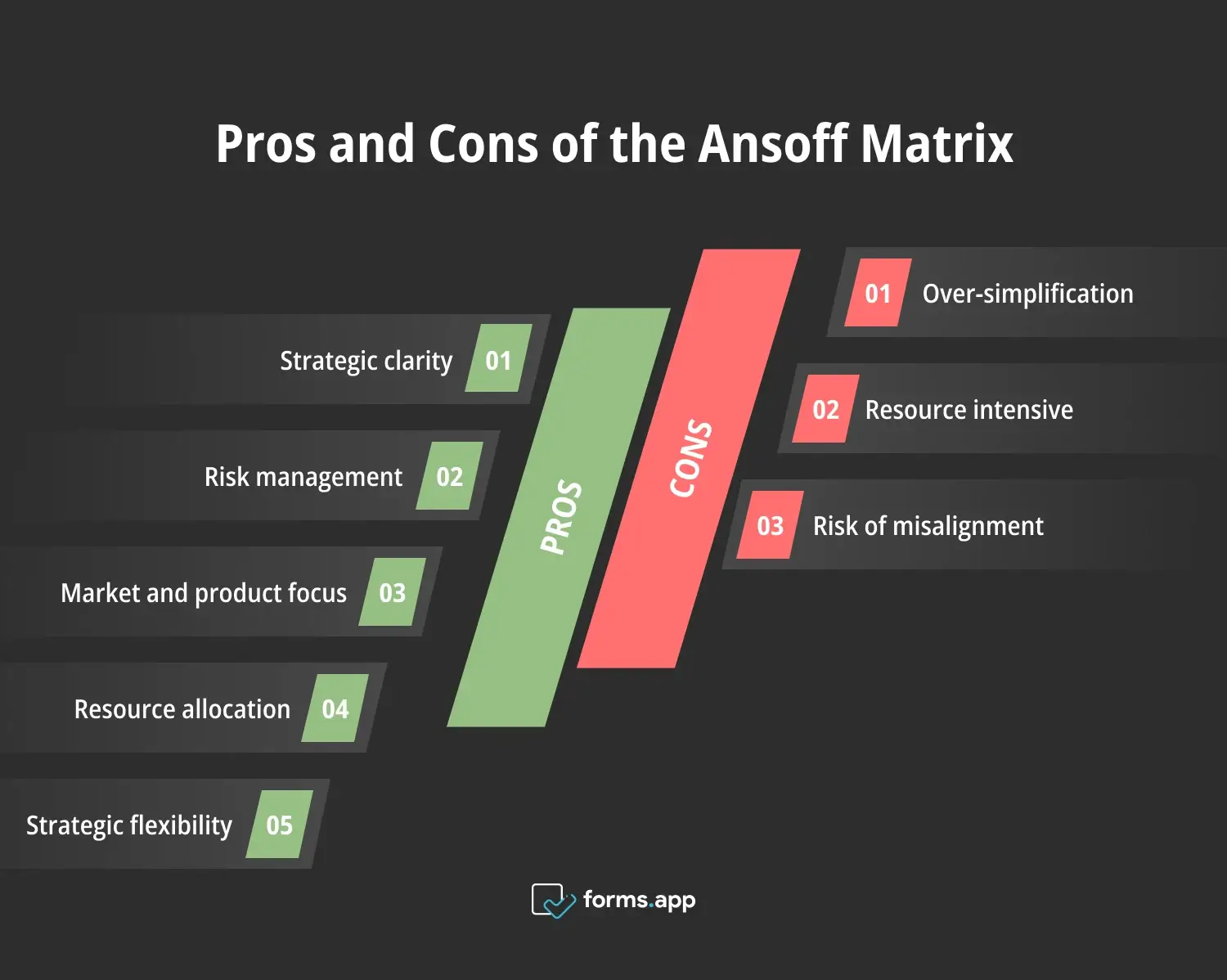
Advantages and disadvantages of the Ansoff Matrix
Pros
➕Strategic clarity: The Ansoff Matrix provides a clear framework for evaluating growth options, helping businesses make informed decisions. By separating strategies into four distinct paths, companies can analyze their options and align them with their overall goals. This clarity aids in focusing on initiatives and allocating resources effectively.
➕Risk management: By assessing the risks associated with each growth strategy, businesses can better prepare for potential challenges. The matrix helps identify high-risk strategies and balance them with lower-risk options. It ensures a more balanced approach to growth. This proactive risk management reduces the likelihood of unforeseen setbacks.
➕Market and product focus: It encourages businesses to consider both market and product dimensions in their plans. This dual focus ensures that companies do not overlook important aspects of their strategy. It promotes a holistic approach to growth, considering all possible avenues for expansion.
➕Resource allocation: Using the Ansoff Matrix helps businesses allocate resources more efficiently by identifying the most promising growth strategies. This targeted allocation ensures that investments are directed towards initiatives with the highest potential return. This optimizes the use of financial, human, and technological resources. Effective resource allocation is key to successful strategy implementation.
➕Strategic flexibility: The Ansoff Matrix provides flexibility in strategic planning, allowing businesses to adapt to changing market conditions and opportunities. By regularly revisiting and adjusting their strategies, companies can stay responsive to market dynamics and maintain their competitive edge. This flexibility ensures long-term stability and growth in a constantly evolving business environment.
Cons
➖Over-simplification: The Ansoff Matrix may simplify too much the market dynamics and strategic decisions, leading to potential oversights. It may not capture all the nuances of a specific market or business situation. Relying solely on the matrix without deeper analysis can result in suboptimal decisions.
➖Resource intensive: Implementing strategies identified through the Ansoff Matrix can be resource-intensive, requiring significant investment in time, money, and effort. Businesses need to ensure they have the necessary resources and capabilities to execute their chosen strategies effectively. This requirement may limit the relevance of certain strategies, especially for smaller companies.
➖Risk of misalignment: One of the disadvantages of the Ansoff Matrix is the misalignment of strategies. They may not be compatible with a company’s core competencies or market conditions. It is essential to complement the matrix with other strategic tools and analyses to ensure a comprehensive evaluation. Misalignment can result in failed initiatives and wasted resources.
How to use the Ansoff Matrix
Understanding how to use the Ansoff Matrix effectively is crucial for strategic decision-making. By exploring its practical applications and step-by-step approach, businesses can leverage this framework to identify growth opportunities and formulate actionable strategies. Let's explore the key steps in using the Ansoff Matrix to drive business expansion.
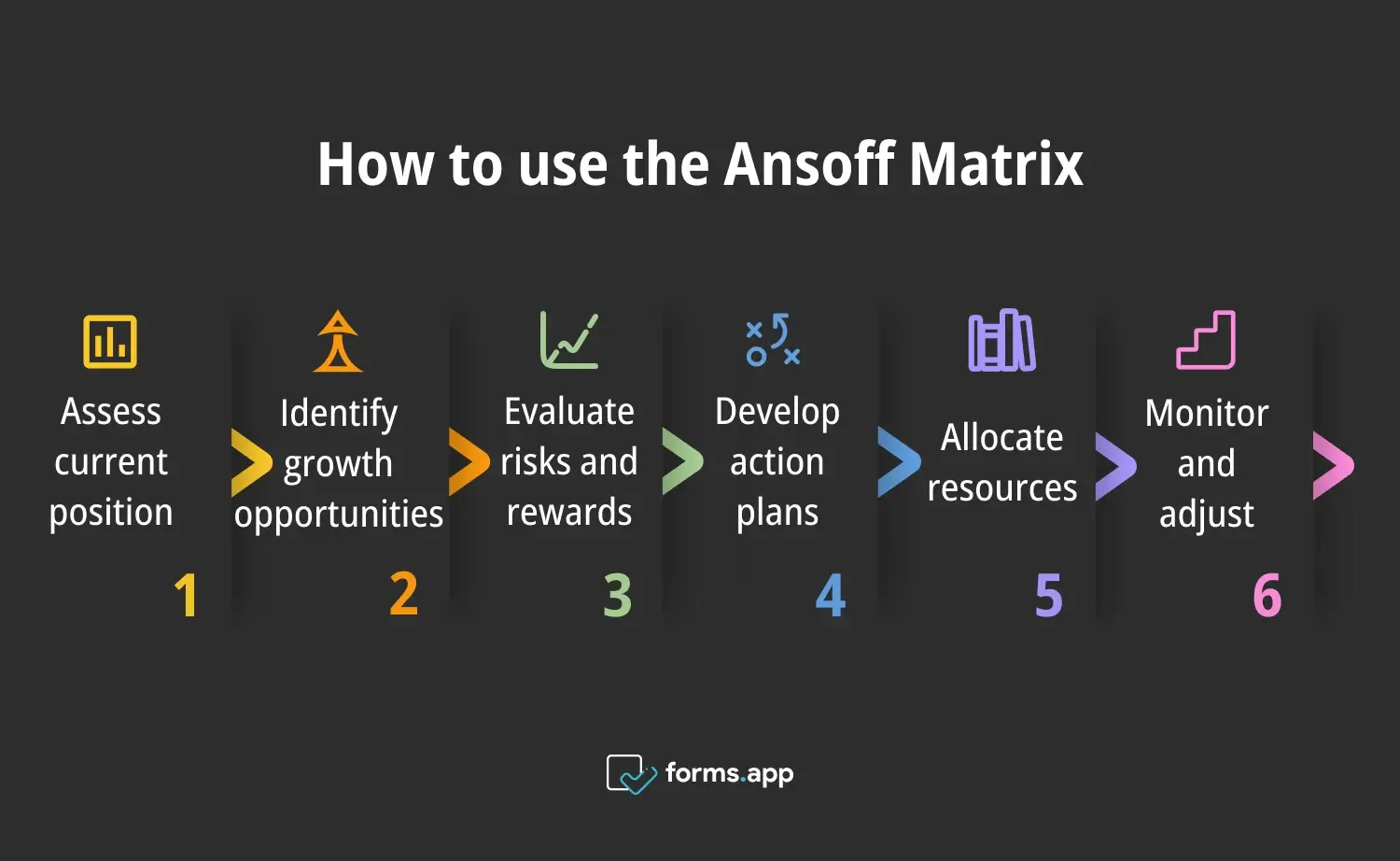
Steps to use the Ansoff Matrix
Step 1: Assess current position
Analyze your current market position. Identify your existing products and markets. Understand your market share, customer demographics, and competitive landscape. This assessment will provide a base for exploring growth opportunities.

💡Gather data on sales performance and market trends.
Step 2: Identify growth opportunities
Use the Ansoff Matrix to brainstorm potential growth strategies. Evaluate each quadrant: Market Penetration, Market Development, Product Development, and Diversification. Consider the possibility and potential impact of each strategy on your business.

💡Engage key stakeholders in brainstorming sessions to generate ideas and insights.
Step 3: Evaluate risks and rewards
Assess the risks and rewards. Market Penetration involves lower risk but may offer limited growth. However, Diversification can lead to growth but comes with higher risk. Balance potential gains against the level of risk you are willing to accept.

💡Conduct a SWOT analysis to evaluate the strengths, weaknesses, opportunities, and threats. You can also benefit from models such as the 4Ps of marketing to get a clearer understanding of your market conditions.
Step 4: Develop action plans
Create detailed action plans for your chosen strategy. Market penetration might include marketing campaigns and customer loyalty programs. For Product Development, outline the steps for research and design, developing new products. Ensure your plans are specific, measurable, achievable, relevant, and time-bound (SMART).

💡Assign responsibilities, set milestones, and allocate resources to each action plan.
Step 5: Allocate resources
Ensure you have the necessary resources to implement your growth strategies. This includes financial resources, personnel, and technology. Allocate resources based on the priority and potential impact of each strategy. Monitor resource usage to stay within budget and timelines.

💡Effective resource allocation ensures that your strategies are well-supported.
Step 6: Monitor and adjust
Regularly review the progress of your growth strategies. Use key performance indicators (KPIs) to measure success. Be prepared to adjust your plans based on market feedback and changing conditions. Flexibility is crucial to respond to unforeseen challenges and opportunities.

💡Continuous monitoring and adjustment ensure that your strategies remain relevant.
When to use the Ansoff Matrix Risk Analysis
Knowing when to use the Ansoff Matrix is essential for strategic market planning. By identifying scenarios where this framework is most beneficial, businesses can make informed decisions about growth strategies. Let's explore the situations and contexts to leverage the Ansoff Matrix. This way, we will be able to yield the most significant strategic insights and outcomes.
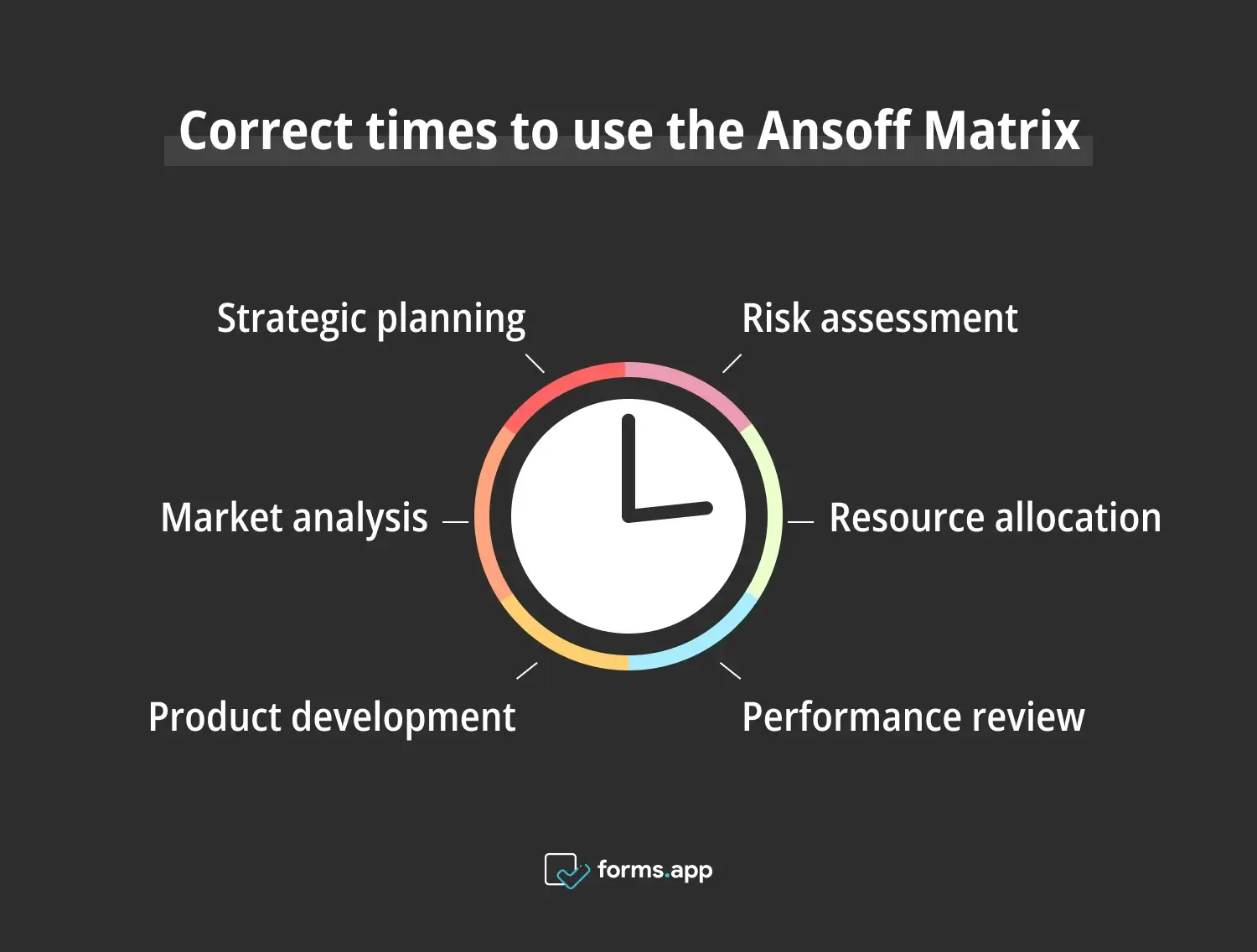
Right times to use the Ansoff Matrix
⏰Strategic planning
Use the Ansoff Matrix during strategic planning sessions to explore various growth options. It helps in visualizing potential strategies and making informed decisions about the future direction of the business. Companies can consider all four quadrants of the Ansoff Matrix. They can identify the most suitable paths for expansion and align their strategic initiatives with their overall goals.
⏰Market analysis
When analyzing new or existing markets, the Ansoff Matrix helps in identifying opportunities and threats. It provides a structured approach to evaluating market potential and understanding competitive dynamics. This analysis, similar to the marketing funnel, is crucial for making informed decisions about market entry, expansion, or diversification.
⏰Product development
The matrix is useful for guiding product development efforts, ensuring they align with market needs and business objectives. It helps in focusing on product innovation initiatives and allocating resources effectively. Companies can consider the Ansoff Matrix Product Development quadrant. Therefore, they can focus on creating new products that meet evolving customer demands.
⏰Risk assessment
Use the Ansoff Matrix to assess the risks associated with different growth strategies. This helps balance risk and reward, ensuring a thoughtful approach to expansion. Companies can analyze the risk levels of each quadrant. They can develop risk mitigation plans and make informed decisions about their growth strategies.
⏰Resource allocation
During resource allocation, the Ansoff Matrix aids in directing investments toward the most promising growth opportunities. This ensures optimal use of financial, human, and technological resources. Effective resource allocation is key to successful strategy implementation and achieving desired growth outcomes.
⏰Performance review
In performance reviews, the Ansoff Matrix helps in evaluating the success of implemented strategies and making necessary adjustments. It provides a framework for assessing progress and identifying areas for improvement. Regular reviews ensure that strategies remain relevant and effective in achieving business objectives.
Frequently asked questions about the Ansoff Matrix
Answering frequently asked questions about the Ansoff Matrix provides clarity on its purpose and application. By addressing common queries, businesses can better understand how to leverage this strategic tool for growth. Let's explore these FAQs to gain insights into maximizing the Ansoff Matrix's effectiveness in business planning.
Ansoffs Matrix, auch bekannt als Produkt/Markt-Erweiterungsgitter, umreißt vier Wachstumsstrategien: Marktdurchdringung, Produktentwicklung, Marktentwicklung und Diversifikation. Die Marktdurchdringung konzentriert sich auf die Steigerung des Umsatzes von bestehenden Produkten in bestehenden Märkten. Die Produktentwicklung beinhaltet die Schaffung neuer Produkte für aktuelle Märkte. Die Marktentwicklung zielt darauf ab, in neue Märkte mit bestehenden Produkten einzusteigen.
Die BCG-Matrix unterscheidet Produkte als Sterne, Cash Cows, Fragezeichen oder Hunde, basierend auf Marktwachstum und -anteil. Die Ansoff-Matrix konzentriert sich auf Wachstumsstrategien und bietet Optionen für Marktdurchdringung, Produktentwicklung, Marktentwicklung und Diversifikation. Beide sind entscheidende Werkzeuge in der Geschäftsplanung und behandeln verschiedene Aspekte der strategischen Entscheidungsfindung.
Wir können reale Beispiele von Ansoffs Matrix bei Apple Inc. sehen:
Es intensiviert das Marketing für das iPhone für Marktdurchdringung. Es bringt auch neue Produkte wie die Apple Watch für Produktentwicklung auf den Markt. Das Unternehmen expandiert in aufstrebende Märkte wie Indien für Marktentwicklung. Und es bietet neue Dienstleistungen wie Apple TV+ für Diversifizierung an.
Coca-Cola nutzt effektiv die Ansoff-Matrix in allen Strategien:
Es verbessert das Marketing für Marktdurchdringung. Es führt neue Getränkevarianten für Produktentwicklung ein. Das Unternehmen betritt neue Regionen wie Afrika für Marktentwicklung. Schließlich expandiert es durch Übernahmen wie Costa Coffee für neue Kategorien und Marktsegmente.
Conclusion
In conclusion, the Ansoff Matrix is a powerful tool for strategic planning. It provides a structured approach to exploring growth opportunities. Businesses can make informed decisions about market and product expansion, balancing risks and rewards. This model aids in achieving sustainable growth and competitive advantage in a dynamic business environment.
In this article, we covered the Ansoff Matrix in detail, including its explanation, components, and practical usage. We also discussed real-life examples, advantages, and when to use this model. Use this guide to apply the Ansoff Matrix effectively in your strategic planning efforts. This tool can be instrumental in driving your business growth and success.
Fatih is a content writer at forms.app and a translator specializing in many text domains, including medical, legal, and technical. He loves studying foreign languages. Fatih especially likes to create content about program management, organizational models, and planning tools.



 11 min lesen
11 min lesen
